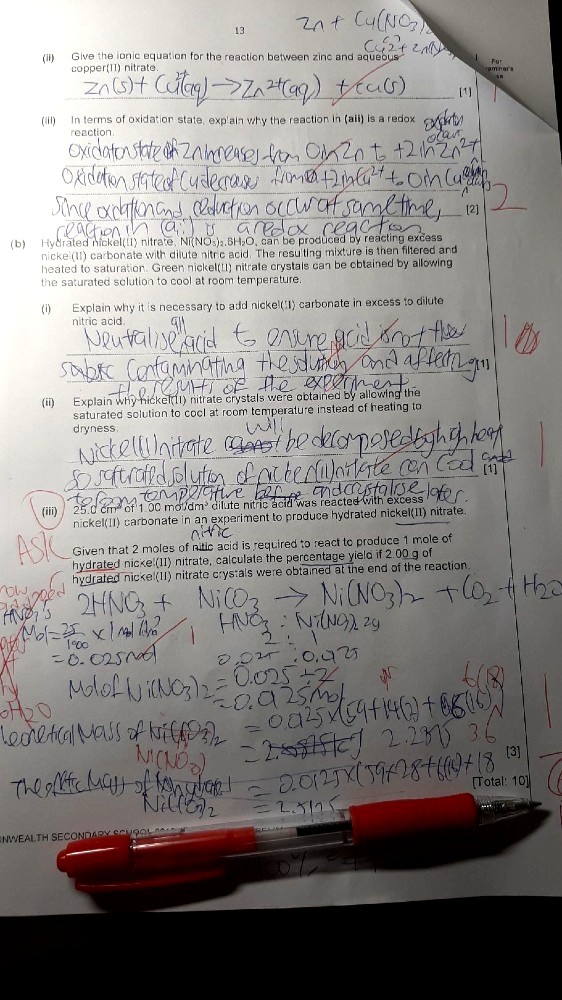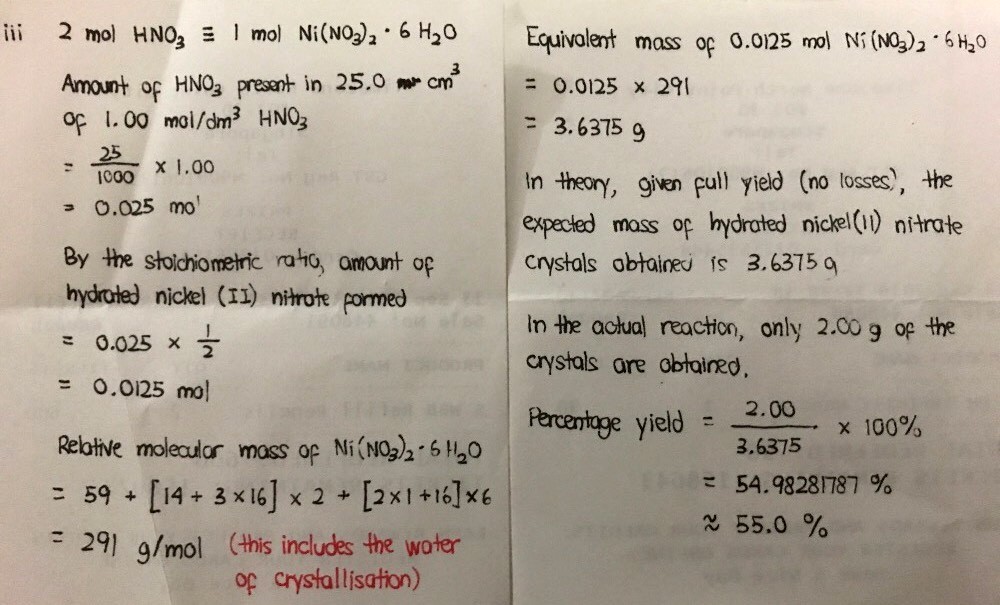Ask Singapore Homework?
Upload a photo of a Singapore homework and someone will email you the solution for free.

Question
secondary 4 | Chemistry
One Answer Below
Anyone can contribute an answer, even non-tutors.

Can i ask why do i have to add in the molecular mass of h2o when calculating molecular mass of nickel nitrate? And why is it 6h2o? Thks
As for why there is “6” water molecules, it highly depends on experimental results. This is explained more in detail at the A Levels. But the number of water molecules is still dependent on the compound itself. There is no general rule of thumb. Some compounds have “5”. Some compounds have “4”. Some coin ponds have more than “6”.
This means that for every 1 formula unit of nickel(II) nitrate , there are 6 water molecules.
(Note the numbers 3 and 2 should be in subscript, unable to type here due to mobile keyboard limitations)
So you must include the water molecules as they are part of the crystals. The question is asking for hydrated nickel(II) nitrate and not nickel(II) nitrate
As for why there are 6 of them , it has to do with formation of stable complexes (typically octahedral in this case). You will learn this in chemistry courses of higher education levels such as A level, IB , polytechnic, and university
As for your equation, it should be
2HNO3 + NiCO3 + 5H2O → Ni(NO3)2.6H2O + CO2
The 5 water molecules are actually from the water in the dilute nitric acid
(Dilute here means that HNO3 is dissolved in water such that the acid concentration of HNO3 is low)
Continued from your working,
Theoretical mass of hydrated nickel(II) nitrate that would be formed
= 0.0125 mol x [59 + 14(2) + 6(16) + 6(2(1) + 16) ) ] g/mol
= 0.0125 mol x 291 g/mol
= 3.6375 g
Since mass obtained is 2.00g,
Percentage yield
= 2.00g/3.6375g x 100%
≈ 54.9828179 %
= 55.0 % (3 s.f.)
J has come up with a brilliant balanced equation which I would not have thought of. Without the 5 H2O placed in that chemical equation, the balancing of the equation would not have been possible. I would have been stuck at this juncture. But secondary school students are not expected to know that the balanced equation must contain the + 5 H2O, since the reactants are not explicitly mentioned to contain water.
Even in solid form, certain substances can be divided into further forms. The first is called anhydrous, where the substance is in its “dry, powdered” state.
When water is actually added to hydrate this, some of these substances do not just dissolve in water and that’s about it. These substances actually gain water molecules to their compounds so that the water molecules become part of the compound, and these water molecules add to the overall relative molecular mass of the compounds. When this happens, these substances are said to be in their “hydrated” state, which is often crystalline. Heating these substances to dryness will cause the substances to return to their “anhydrous” state.
The number of water molecules attached to different hydrated substances varies across substances. Gypsum, for example, is a natural substance which contains. calcium sulphate with 2 water molecules attached to it. In another case, copper (II) sulphate has 4 water molecules attached to it during crystallisation. Interestingly, copper (II) sulphate crystals are blue in colour. What I did not realise is that anhydrous copper (II) sulphate is white!
The number of water molecules added is explained more at the higher level, both in theory and in real life experiments. We are unable to tell exactly how many water molecules there will be in the O Levels.
The idea of this water of crystallisation is not exactly taught in the O Level syllabus, which is why the writing of the full chemical equation is not expected and they provided you with the information that there are 6 water molecules attached to the nickel nitrate, but the question is still solveable at the O Levels with your current knowledge of what you have learnt.
As for balancing the equation however, you would be expected to know how to balance it.
Seeing a 6 H2O in the right hand side, the question expects you to infer that you will need some H2O on the left hand side to balance it as well.
Since dilute nitric acid is used, you would be expected to know that it contains mainly water and therefore that is the source of the water molecules.
Therefore the balancing of the equation is expected, even though the question does not mention explicitly that the reactants contain water.
If you're interested to know why there are 6H2O in the first place, you could start from something like this :
https://en.m.wikipedia.org/wiki/Water_of_crystallization
http://www.freechemistryonline.com/water-of-crystallization.html
I would say this is a higher level question that is meant to distinguish the students.
See 1 Answer





